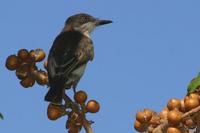|
| 질의: Forest frog | 결과: 131번째/187 | |
Loggerhead flycatcher (Puerto Rican race, Tyrannus caudifasciatus taylori)

| 해상도: 650x433
파일크기: 22868 Bytes
등록시간: 2008:01:28 15:02:01
|
metazoa16
[[ Family
Tyrannidae: Tyrant Flycatchers ]]
[[ The tyrant
flycatchers are a group of usually drab-looking birds that are
generally poor songsters as well. (Indeed, the term "songbird" does not
mean that a particular species within the order sings well). Kingbirds, pewees,
and elaenias of one sort or another inhabit every Caribbean island. Notorious for
being rather pugnacious (and hence the name of the entire family), kingbirds are creatures of savannas, woodlands, and forest
canopies. Elaenias and pewees are smaller, and occupy
similar general habitats, but are segregated from kingbirds and each other by occupying
somewhat different structural niches, especially in forests' understories and in
scrubland. While most species are insectivores, larger ones will capture and
devour prey like lizards frogs. ]]
[[ Some kingbirds are so aggressive as to give chase and harass far larger birds
like hawks and herons whenever these enter their territories. Only hummingbirds
in this region are as bold in attacking intruders. ]]
Loggerhead flycatcher (Puerto Rican race, Tyrannus caudifasciatus taylori). |
^o^
동물그림창고 똑똑전화 누리집
^o^
|
|